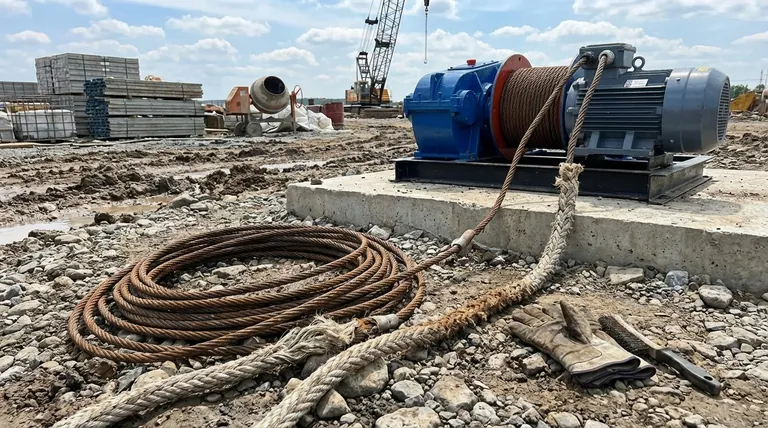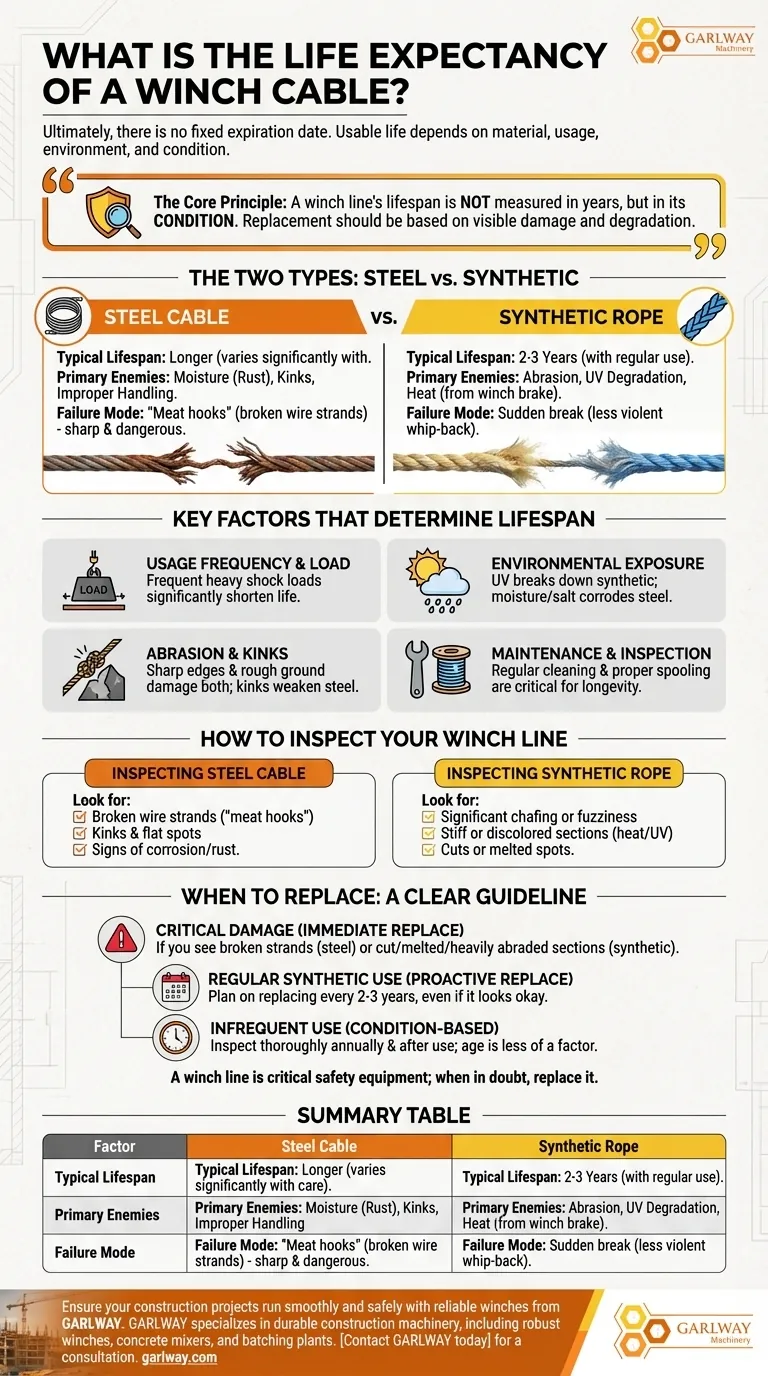Ultimately, there is no fixed expiration date for a winch cable. The usable life of a synthetic winch rope, if used regularly, is typically two to three years, while a well-maintained steel cable can last significantly longer. However, its actual lifespan depends entirely on the material, frequency of use, environmental exposure, and most importantly, its physical condition as determined by regular inspections.
The core principle is this: A winch line's lifespan is not measured in years, but in its condition. Replacement should be based on visible damage and degradation, not a calendar date.

The Two Types of Winch Lines: Steel vs. Synthetic
The lifespan of your winch line is first and foremost dictated by its material. Steel cable and synthetic rope wear out in fundamentally different ways.
Steel Cable
Steel wire rope is the traditional choice, known for its extreme durability against abrasion. It holds up well when dragged over rocks and rough terrain.
Its primary enemies are moisture, which causes rust from the inside out, and improper handling, which leads to kinks and flat spots. Its most dangerous failure mode is the development of broken strands, known as "meat hooks," which can easily slice through skin.
Synthetic Rope
Synthetic rope (like Dyneema®) is significantly lighter, stronger for its weight, and safer because it stores less kinetic energy. If it breaks, it is much less likely to whip back violently.
However, synthetic rope is highly vulnerable to abrasion on sharp edges, heat from the winch drum's brake, and long-term UV degradation from sunlight, which can make it brittle.
Key Factors That Determine Lifespan
Regardless of material, several factors will accelerate the wear and tear on your winch line.
Usage Frequency and Load
A winch line used weekly in harsh recovery situations will have a much shorter life than one used twice a year for light tasks. Heavy shock loads place far more stress on the line than smooth, steady pulls.
Environmental Exposure
Sunlight is the primary enemy of synthetic rope, breaking down its fibers over time. For steel, constant exposure to water, mud, and road salt will accelerate rust and internal corrosion.
Abrasion and Kinks
Dragging any line over sharp rocks or rough ground will cause damage. For steel, improper winding can cause crushing and kinking, which creates a permanent weak point. For synthetic, even moderate abrasion can sever crucial fibers.
Maintenance and Inspection
This is the most critical factor. A winch line that is regularly cleaned, inspected, and properly spooled will always outlast one that is neglected. Proactive maintenance is the key to both longevity and safety.
How to Inspect Your Winch Line
Knowing when to replace your line comes down to knowing what to look for. Perform an inspection after every single use.
Inspecting Steel Cable
Unspool the cable completely, looking for broken wire strands ("meat hooks"). If you find several broken strands in one area, the cable's integrity is compromised. Also, check for any kinks, flat spots, or signs of corrosion.
Inspecting Synthetic Rope
Look for significant chafing or fuzzy areas, which indicate abrasion. Check for stiff or discolored sections, which are signs of heat damage or UV degradation. Any cuts or melted spots are immediate grounds for replacement. Finally, feel for grit embedded within the rope's weave, which can slowly sever fibers from the inside.
When to Replace: A Clear Guideline
Your decision should be based on inspection, not just age. However, some general rules can guide you.
- If you see critical damage: Replace the line immediately. This includes broken wire strands on steel or any melted, cut, or heavily abraded sections on synthetic rope.
- If you use your synthetic rope regularly: Plan on replacing it every 2-3 years as a matter of proactive safety, even if it looks okay.
- If you use your winch infrequently: Age is less of a factor than condition. Perform a thorough inspection at least once a year and after any use.
A winch line is a critical piece of safety equipment; when in doubt, replace it.
Summary Table:
| Factor | Steel Cable | Synthetic Rope |
|---|---|---|
| Typical Lifespan | Longer (varies with care) | 2-3 years with regular use |
| Primary Enemies | Moisture (rust), kinks | Abrasion, UV degradation, heat |
| Key Inspection Focus | Broken strands, kinks, corrosion | Fuzziness, stiffness, cuts, melting |
| Failure Mode | "Meat hooks" (broken wires) | Sudden break with less whip-back |
Ensure your construction projects run smoothly and safely with reliable winches from GARLWAY.
Your winch cable is a critical safety component. Don't risk equipment failure or job site accidents. GARLWAY specializes in durable construction machinery, including robust winches, concrete mixers, and batching plants built for the demands of construction companies and contractors.
We can help you select the right equipment and provide expert advice on maintenance to maximize uptime and safety on your projects.
Contact GARLWAY today for a consultation and let's discuss how our solutions can power your success.
Visual Guide

Related Products
- Electric and Hydraulic Winch for Heavy Duty Applications
- Portable Small Trailer Winch
- Electric 120V Boat Winch by Badlands
- Heavy Duty Electric Boat Winch Windlass Anchor
- Electric Hoist Winch Boat Anchor Windlass for Marine Applications
People Also Ask
- How to power an electric winch on a trailer? Choose the Best Method for Your Setup
- How do I choose an electric winch? A guide to safe and effective pulling power.
- Do electric winches have brakes? Essential Safety for Your Heavy-Duty Pulling
- Can an electric winch be used as a hoist? Understand the Critical Safety Differences
- How is an electric winch powered? Unlock the Power Conversion System for Heavy Lifting







